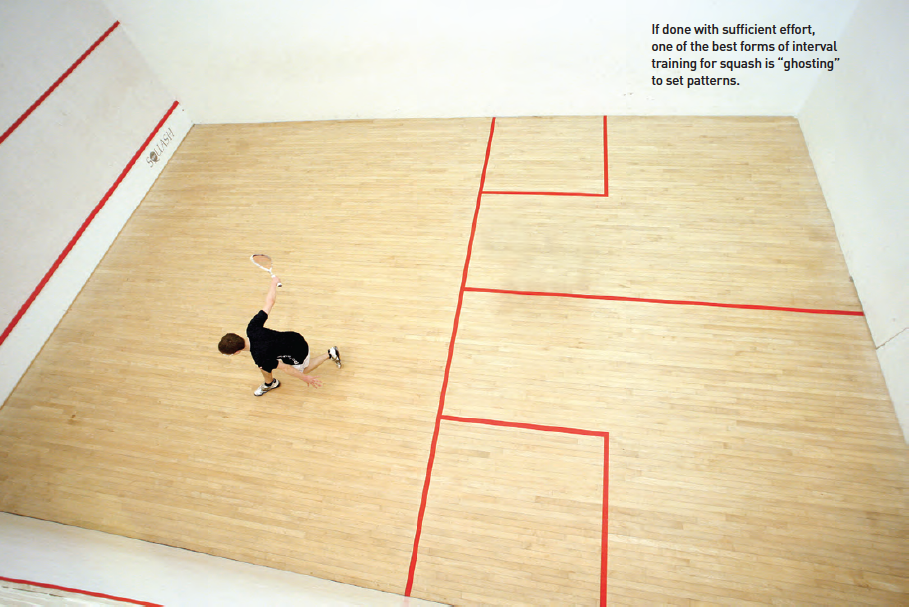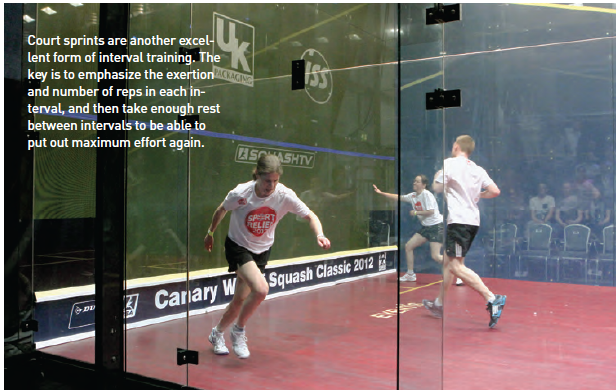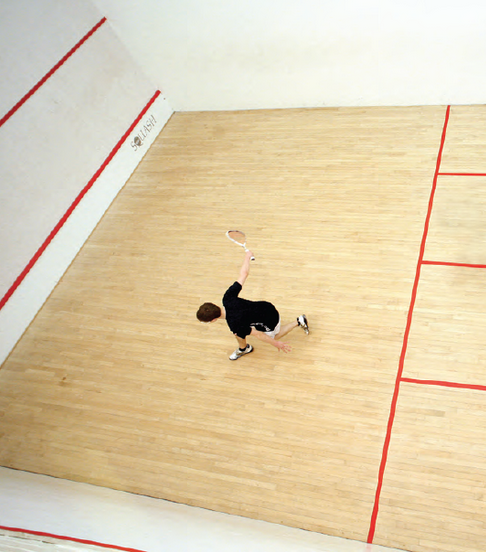By Damon Leedale-Brown, Sports Scientist & Conditioning Specialist
In the follow up to our first article on Interval Training let’s consider some of the typical questions and uncertainties players have around performing interval training: How much rest should I take between intervals? How many intervals shall I do for and for how long? How hard should I be working? Shall I do bike intervals or running? What about on court movement training?
Work versus Rest
The main method most people use for interval training would be the standard work-to-rest technique where you have a set work period and a set rest or recovery period. A general rule of thumb for this technique would be the longer the interval time the shorter the rest taken as a percentage of the interval. This is essentially because short intervals performed at maximal intensity and with a higher muscular demand will require a longer rest relative to the interval. General guidelines on work-to-rest times to help get you started would be:
• 15-20 seconds work—beginner athletes would typically need at least 45-60 seconds recovery (a ratio of 1:3 work to rest) while more advanced athletes will need around 30-40 seconds recovery (ratio of 1:2).
• 30 second work effort—recovery period of 60-90 seconds (1:2 for advanced, 1:3 for beginners).
• 60 seconds of work—recovery period of 1 to 2 minutes (1:1 or 1:2).
As the work interval increases the recovery time typically will not need to be as long in relation to the interval. So, for example, a 2 minute work interval may only need to be followed by a 2 minute rest or for an advanced athlete even a little as a 1 minute rest.
Heart Rate Recovery:
An alternative to the standard work-to- rest interval training technique would be to use heart rate as a measure of physiological recovery as opposed to an arbitrary time period. With the advent of accurate and low-cost heart rate monitors this is now becoming more the method of choice for interval training amongst the World’s leading conditioning specialists and sports physiologists.

While heart rate is not a direct or completely error free measure of work intensity or indeed recovery, it is still considered a far better approach than simply choosing a set time interval to rest.
So how do we set an appropriate recovery heart rate during interval training? Many of the World’s leading experts have moved towards using a method known as the Heart rate Reserve or Karvonen formula:
Maximum heart rate minus resting heart rate, times percent, plus resting heart rate equals target/recovery heart rate.
So as an example if you wanted to set your recovery heart rate at 60% (0.6) and had a maximum heart rate** of 190bpm and a resting rate of 50bpm then the calculation would be:
(190 – 50) × 0.6 + 50 = 134bpm
**If you do not know your maximum heart rate then you would have to base it on the 220 minus age formula—this will be less accurate than a true maximum heart rate reading but at least will get you started.
Using the above example you would wait until your heart rate had returned to a value of 134bpm before starting the next work interval. This method essentially means that each recovery period will be of different length, with the recovery time typically increasing in length as the number of intervals completed increases. For a well conditioned athlete it will often mean that the initial recovery time is rapid, with rest intervals similar to or shorter than the work intervals in the first repetitions.
My personal feeling is that the Heart Rate Recovery method works better with longer work intervals (40 seconds or greater). For shorter intervals heart rate is not necessarily a good indicator of intensity. Your heart rate takes time to elevate, and intervals of 30 seconds or less are not typically long enough to allow the heart rate of a trained athlete to reach maximal levels.
Number of Intervals & Intensity?
When undergoing an interval program of any nature you should start conservatively in terms of the number of repetitions. I would recommend no more than 4-6 intervals initially (depending on the duration) and then build progressively from that point forwards.

One of the typical errors made with interval training is athletes starting with too many intervals and too little recovery. In this situation the interval session quickly turns into a steady paced endurance session with breaks! Remember the goal of each interval is to maintain a high work intensity for the duration of that interval. This becomes difficult to achieve especially with unconditioned athletes if the number of intervals is too high or the recovery periods too short. It also highlights the value of the heart rate recovery method to observe how an athlete is actually coping physiologically with the session, and it helps to ensure their recovery period is sufficient to allow for a maximal effort on the subsequent rep.
What activity should I use?
I am a big proponent of on-court interval training and believe that a considerable amount of interval training should be courtbased. This could take the form of movement training (ghosting) working to set patterns, or could be based around specific speed and agility drills using footwork ladders and cones. I have had tremendous success using many variations of this type of court-based interval training with the World Ranked Pro players I have worked with, and apply these principles of on court interval training with all the junior players who train with me.
Off-court interval sessions based around running are probably the most effective in terms of physiology but are typically the most likely to cause injury. Where possible, I would try and base running sessions around forms of shuttle running which bring in acceleration, deceleration and change of direction—all very important aspects of athletic ability on the squash court. Hill running sessions can provide an immense physical and mental challenge (refer to the previous issue and our Colorado Camp Hill session!). Make sure to build up the gradient and number of repeats gradually.
Stationary bike intervals are probably the safest option for less skilled and poorly conditioned athletes (at least initially), and have value for athletes with injury issues that preclude them from running-based sessions.
My hope is that this article has given you great insight into how to structure an interval training session/program, and what training activities might be best suited to you at this stage in your development as a player. Next month my aim is to provide examples of interval sessions performed by a number of the World’s leading players.





